Table of Contents
Last month, I stood in my local coffee shop, staring at a bag of beans that cost more than my dinner budget for two days. The price tag read $75 for just one pound of Jamaican Blue Mountain coffee. Was I crazy to even consider it? Maybe. But what happened next completely transformed my understanding of what makes coffee truly worth its price. The experience made me question everything I thought I knew about coffee pricing, quality, and value – leading me down a rabbit hole of discovery that I’m about to share with you.
The Truth About Expensive Coffee

Not all expensive coffee is created equal. After testing over 200 different coffees ranging from $5 to $100 per pound, I’ve discovered something surprising: price often has little to do with quality. Some of my favorite coffees cost under $20 per pound, while some expensive ones left me wondering if I’d just paid for fancy packaging. The real revelation came when I started mapping price against actual taste experiences, farmer practices, and processing methods. What emerged was a complex web of factors that influence coffee prices, many of which have nothing to do with what ends up in your cup.
What You’re Really Paying For

The price tag on premium coffee typically reflects:
- Growing region and altitude
- Processing method
- The rarity of the beans
- Labor practices and farmer wages
- Marketing and packaging
- Brand name premium
- Shipping and handling costs
- Certification fees (organic, fair trade, etc.)
- Storage and preservation methods
- Roaster’s expertise and reputation
Breaking Down the Cost Tiers
- Budget Coffee ($5-15/lb): These aren’t necessarily bad. Many local roasters offer excellent beans in this range. You’ll find good Colombian, Brazilian, and Indonesian coffees here. What you might miss are the complex flavor notes and unique characteristics of more expensive varieties. However, don’t dismiss these entirely – some budget coffees from small, local roasters can outperform their expensive counterparts. The key is finding roasters who prioritize quality over quantity, even at lower price points.
- Mid-Range ($15-30/lb): This is the sweet spot for most coffee lovers. You’ll find single-origin beans, specialty blends, and even some rare varieties. The quality jump from budget to mid-range is often dramatic, while the leap from mid-range to premium can be subtle. These coffees typically offer the best balance of quality and value, providing complex flavors without breaking the bank. Many award-winning coffees actually fall into this category, proving that excellence doesn’t always require a premium price tag.
- Premium ($30-50/lb): Here’s where things get interesting. These coffees often come with stories – small batch processing, experimental fermentation, award-winning farms. Are they worth it? Sometimes. The key is knowing which premium coffees justify their price tag. What you’re often paying for at this level is uniqueness rather than just quality. These beans might come from micro-lots, undergo special processing, or represent experimental varieties. The best premium coffees offer something truly distinctive – flavors, aromas, or experiences you simply can’t find in lower-priced options.
- Ultra-Premium ($50+/lb): Welcome to the realm of Kopi Luwak, Jamaican Blue Mountain, and Gesha coffees. These are the Ferraris of the coffee world – impressive, exclusive, but not necessarily your everyday drive. Some justify their astronomical prices through genuinely rare production methods or extremely limited availability. Others, frankly, are more about bragging rights than superior taste. I’ve found that many ultra-premium coffees are fascinating to try once, but few warrant regular purchases. Even among coffee professionals, these are often viewed as special occasion coffees rather than superior daily drinkers.
The Blind Taste Test Revelation
I recently hosted a blind tasting with friends, featuring coffees from each price tier. The results shocked everyone:
- A $22 Ethiopian Yirgacheffe beat out a $65 Gesha
- The $75 Blue Mountain ranked third overall
- A $18 Colombian tied with a $45 specialty blend
- The lowest-ranked coffee? A $55 “premium” blend
What made this experiment particularly interesting was watching how people’s perceptions changed when we revealed the prices. Several participants tried to change their rankings, suddenly “discovering” subtle notes in the expensive coffees they’d initially dismissed. This psychological aspect of coffee tasting revealed how deeply price influences our expectations and enjoyment.
What Makes Expensive Coffee Worth It?

After years of testing, here’s when premium coffee actually justifies its price:
- Unique Processing Methods: Some expensive coffees undergo special fermentation or processing that genuinely creates distinct flavors. These can be worth trying for the unique experience, even if they don’t become your daily brew. For instance, anaerobic fermentation can create fascinating fruit-forward profiles that are impossible to achieve through traditional processing. The extra labor and expertise required for these methods often justify higher prices.
- Ethical Production: Higher prices often mean better wages for farmers and sustainable farming practices. If this matters to you, paying more can align with your values while ensuring quality coffee. Many premium coffees support innovative agricultural practices, community development projects, and environmental conservation efforts. Your purchase becomes an investment in sustainable coffee farming’s future.
The Smart Way to Try Expensive Coffee
Before investing in premium beans:
- Buy small quantities first
- Ask for samples when possible
- Split costs with other coffee enthusiasts
- Research the specific variety and producer
- Check reviews from trusted sources
- Attend cupping sessions at local roasters
- Join coffee subscription services that offer sample sizes
- Connect with online coffee communities for recommendations
- Document your tasting experiences
- Consider the season and freshness factor
The Bottomline About Your Daily Cup
Here’s what I’ve learned after spending thousands on coffee: your daily brew doesn’t need to break the bank. Find a reliable mid-range coffee you love for everyday drinking, and save the premium stuff for special occasions. This approach lets you enjoy the best of both worlds without guilt or budget strain. Remember, the most expensive coffee isn’t always the most enjoyable – it’s about finding what works for your palate and lifestyle. I’ve discovered that my perfect morning cup usually comes from beans in the $18-25 range, while I save those premium purchases for weekends and special occasions.
The Real Value of Your Daily Cup

The perfect cup of coffee isn’t about price – it’s about finding what you truly enjoy. Sometimes that’s a $15 bag of locally roasted beans, sometimes it’s a $50 special reserve. What matters is understanding what you’re paying for and making informed choices about when to save and when to splurge. The joy of coffee isn’t in its price tag but in the daily ritual, the flavors you discover, and the moments it creates. Whether you’re sipping a budget-friendly blend or savoring a rare single-origin, the best coffee is the one that brings you happiness with every cup.

I’m Audrey, a dedicated mother of teenagers with an insatiable love for coffee. On BeanBrewLove.com, I intertwine my need for caffeine with reflections on life. Whether expressing a nostalgic sentiment or injecting a hint of sarcasm, my blog is a reservoir of coffee culture, brewing techniques, and global coffee reviews.




